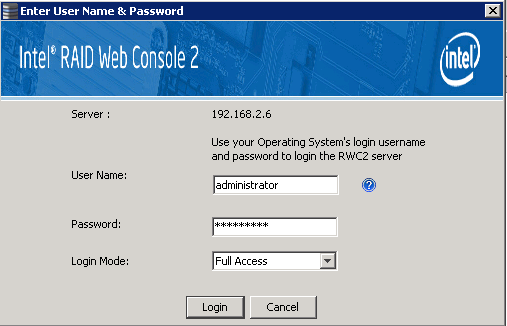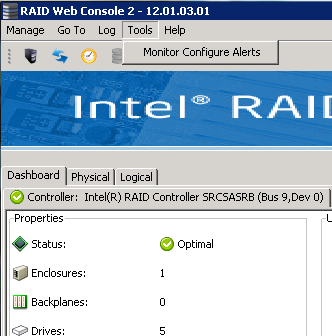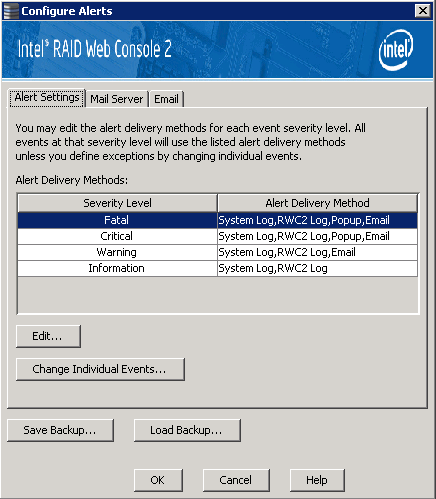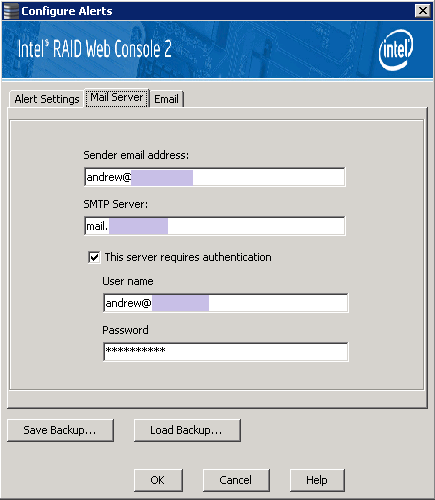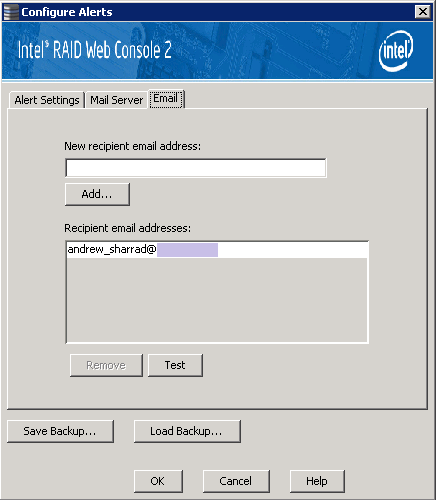Why Use RAID
RAID systems can add resilience against disk failures and/or combine the performance of many disks into a fast single volume. It is important that any faults or error messages with RAID systems are promptly examined to ensure that data is protected.
How to Monitor the RAID
You should always keep installed the RAID monitoring software for your RAID adapter. This includes:
- The LSI MegaRAID storage console (MSM) for LSI Hardware RAID Adapters.
- The Intel Raid Web Console 2 (RWC2) for Intel Hardware RAID Adapters or modules.
- The Intel Matrix Storage Console for SATA/AHCI controller based software RAID systems.
Hardware RAID is recommended for most server applications and this article deals with the management of an Intel Hardware RAID system.
Dos and Don'ts
- Always ensure that the proper RAID driver is installed and running. Do not rely on Microsoft provided RAID drivers. Driver version 6.x is recommended for Intel or LSI Hardware RAID Adapters.
- Always ensure that the latest RWC2 or MSM is installed. Minimum versions below:
- For Intel adapters SRCSASRB, SRCSATAWB or RS2BL080, RWC2 version 12 or later should be installed.
- For second generation 6G adapters such as RMS25CB080, RWC2 version 14 or later should be installed.
- For first generation 12G adapters such as RS3DC080, RWC2 version 15 or later should be installed.
- Download MSM from the LSI/Avago web site and Intel RWC2 from the Intel site.
- If your system is old and being re-purposed or taken offline for maintenance, consider upgrading the firmware on your RAID controller. Ensure that the drivers are up to date and that you have a full, tested, disaster recovery backup first.
- Don't re-use desktop harddrives to replace server harddrives
- If a harddrive fails, replace the hard drive. Do not attempt to re-use a failed hard drive.
Planning your RAID System
When planning and implementing your storage system, consider the performance, capacity and resilience that your system requires.
For example, a VMWare virtual server in a SAN environment may be able to run the operating system using RAID1, as the operating system disks have little load most of the time (unless the system has more virtual RAM committed to guest operating systems than physical RAM available, in which case VMWare may page to disk and this will put a load on the local storage).
Another example is a file server with a large RAID array. In this situation, consider using RAID6 and possibly include a hot-spare as well.
Monitoring
Especially when the server is not in a location where you can hear audible failure messages, it is important to set up email alerting. Even if the server is is in a place where you would normally hear an alarm, the use of email alerts can help you be aware of problems when you are away from site.
Use the MSM / RWC2 Email Notification Feature
Steps to Setup Monitoring
- Login to RWC2 / MSM (use your Windows Administrator or Domain Administrator password to do this)
- Then, under Tools, click on Monitor Configure Alerts
- Use the Alert tab to confirm which type of event gets notified using the right delivery methods. For example, you do not want Information events delivered by email.
- Then use the Mail Server tab to configure the SMTP server settings. Example below.
- Finally, use the Email tab to list the recipients that should receive the email notifications.
Finally
Please review our other RAID articles as these cover topics such as troubleshooting, the RAID levels available, and the differences between desktop and enterprise class hard drives.
Applies to:
- All products capable of RAID functionality
